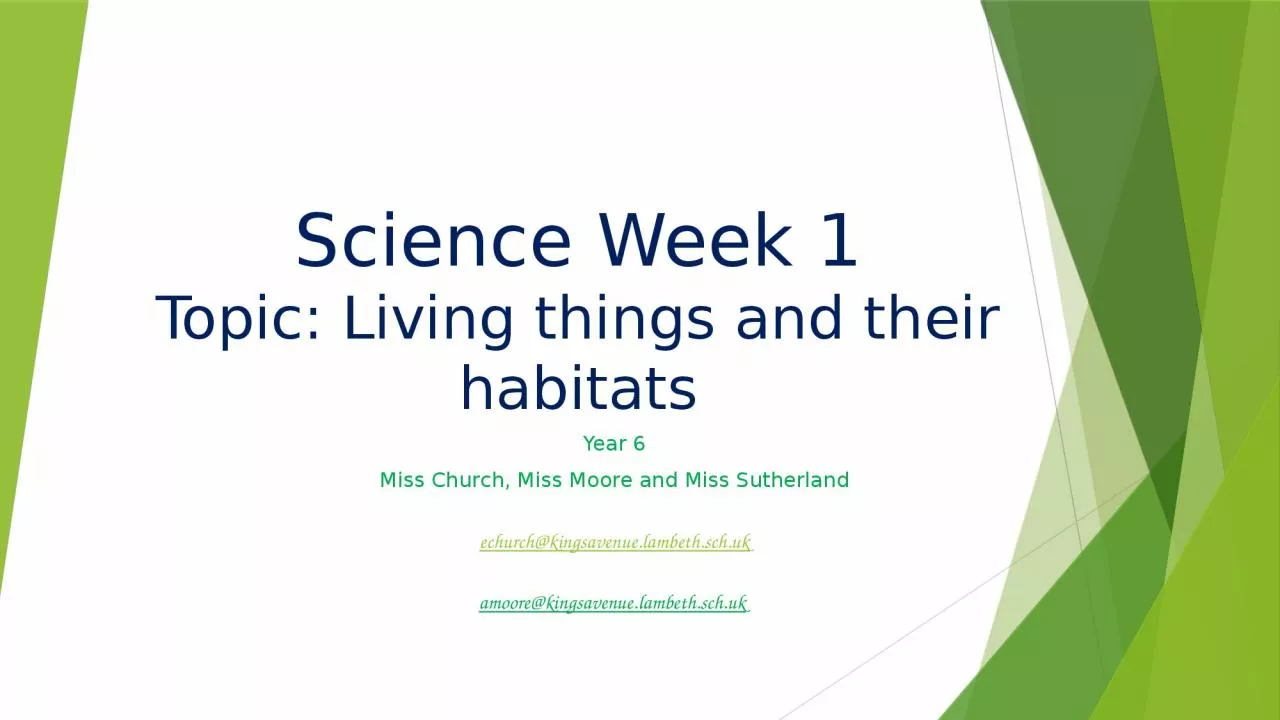

Year 6 Miss Church Miss Moore and Miss Sutherland echurchkingsavenuelambethschuk amoorekingsavenuelambethschuk Lesson 1 lets get started SKLO To understand what a microorganism is ID: 1048361
Download Presentation The PPT/PDF document "Science Week 1 Topic: Living things and ..." is the property of its rightful owner. Permission is granted to download and print the materials on this web site for personal, non-commercial use only, and to display it on your personal computer provided you do not modify the materials and that you retain all copyright notices contained in the materials. By downloading content from our website, you accept the terms of this agreement.
1. Science Week 1Topic: Living things and their habitatsYear 6Miss Church, Miss Moore and Miss Sutherlandechurch@kingsavenue.lambeth.sch.ukamoore@kingsavenue.lambeth.sch.uk
2. Lesson 1- let’s get started!
3. S.K.LO: To understand what a microorganism isW.S.L.O: To plan an enquiry over time
4. Success CriteriaAimI can describe and investigate helpful and harmful microorganisms.I can identify types of microorganism.I can describe helpful and harmful microorganisms.I can investigate harmful microorganisms.
5. What Are Microorganisms?Microorganisms are very tiny living things. They are so small that they are not visible to the naked eye, so a microscope is needed to see them.Microorganisms can be found all around us. They can live on and in our bodies, in the air, in water and on the objects around us. They can be found in almost every habitat on Earth.watch: https://www.bbc.com/bitesize/articles/zsgtrwx
6. What Are Microorganisms?A magnified image of a household dust mite.Some animals and plants are microorganisms. Examples include dust mites and plankton.Photo courtesy of arkhangellohim @flickr.com) - granted under creative commons licence – attributionPhoto courtesy of picksfromoutthere (@flickr.com) - granted under creative commons licence – attributionPlankton are microscopic organisms drifting in fresh or sea water, including plants and animals.
7. What Are Microorganisms?Mould is the common word for any fungus that grows on food or other materials.Other microorganisms are fungi, such as mould, yeast and Penicillium.Photo courtesy of nsalt @flickr.com) - granted under creative commons licence – attributionPenicillium fungus is used to make the antibiotic penicillin.Yeast is a microscopic fungus that can be used to raise bread dough.Photo courtesy of mmu-engage @flickr.com) - granted under creative commons licence – attributionPhoto courtesy of notahipster (@flickr.com) - granted under creative commons licence – attribution
8. What Are Microorganisms?Photo courtesy of niaid @flickr.com) - granted under creative commons licence – attributionBacteria are single-celled microorganisms. Bacteria are found in diverse habitats all over the Earth.This image was produced by a scanning electron microscope. It shows a clump of staphylococcus epidermidis bacteria that is typically found growing on human skin, usually harmlessly.
9. What Are Microorganisms?Sometimes viruses are called microorganisms, but they are not really alive. They are infectious agents that can replicate only inside the cells of living things. Scientists disagree on whether or not to call viruses microorganisms. In this lesson we will consider them to be unusual microorganisms.Photo courtesy of kat m research @flickr.com) - granted under creative commons licence – attributionThis image is a scanning electron micrograph of an influenza virus particle. This microorganism could cause you to have the flu.
10. Helpful or Harmful?Some microorganisms can be helpful in certain situations. Others can be harmful, and their spread needs to be controlled or contained.
11. Helpful or Harmful?Bacteria are used to ferment milk as part of the cheese making process.These examples show some of the helpful uses of microorganisms.Yeast ferments the carbohydrates found in grapes to make alcoholic wine.Yoghurt is made using milk that has been soured by bacteria.Yeast is added to bread dough to make it rise.Microorganisms feed on leaves, plants and other matter, decomposing it and creating compost.Antibiotics are used to kill bacteria that cause infections. They are created from fungi such as Penicillium.
12. Helpful or Harmful?Food poisoning can be caused by bacteria that grow on uncooked or undercooked food.These examples show how microorganisms can be harmful to us. Harmful microorganisms are often called germs.Chicken pox is caused by a virus. It spreads very easily.The influenza virus causes flu symptoms, such as a headache and fever.Athlete's foot is caused by a fungus that grows between the toes.Plaque on our teeth is formed when bacteria in the mouth combine with small food particles.The fungi that grow on food are called moulds. Mould can make you ill if you eat it.
13. Mixed up MicroorganismsThese names of microorganisms have been mixed up! Can you and your talk partner work out what they should say? sayetlodumrisuv
14. Mixed up MicroorganismsHow did you do? yeastmouldvirusWhat does each microorganism do?
15. Task- What Makes Mould Grow?Mould is the name for the types of fungi that grow on food. What do you think makes mould grow?It is useful to know what makes mould grow so that we can stop it happening as fast, and keep our food fresher for longer.You will use 3 slices of bread and 3 clear plastic bags. You will place each slice of bread in a plastic bag and then decide which one variable you want to change. For example, you may put one slice of bread in a very light place and one in a very dark place. The third slice of bread will be a control that stays in the plastic bag in the normal home environment. Or one may go in a very cold place such as the fridge or freezer and the other a very warm place such as over a radiator. The control bag will again just stay in the normal warmth of the home environment. You do not have to use a whole piece of bread, but keep the amount you do use the same size so it is a fair test.
16. Task- What Makes Mould Grow?Back on the school website, there is a instruction page for you to download to help you with the experiment!Leave the bread for as long as you can (9-10 days is perfect!)
17. Remember to email over the work that you have done so we can see what you’re getting up to! echurch@kingsavenue.lambeth.sch.ukamoore@kingsavenue.lambeth.sch.uk